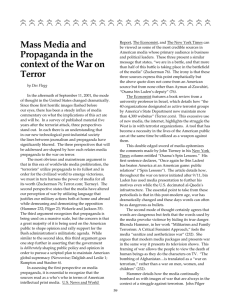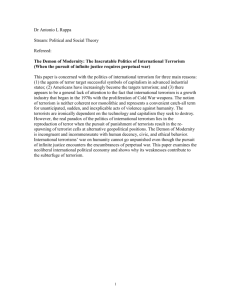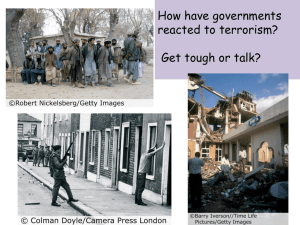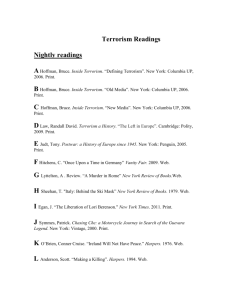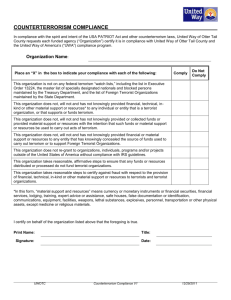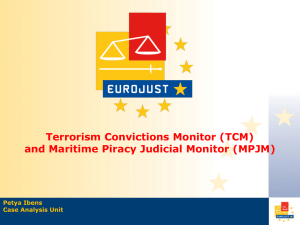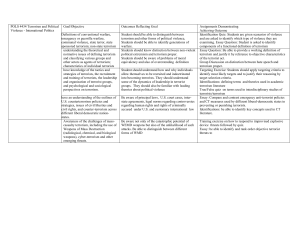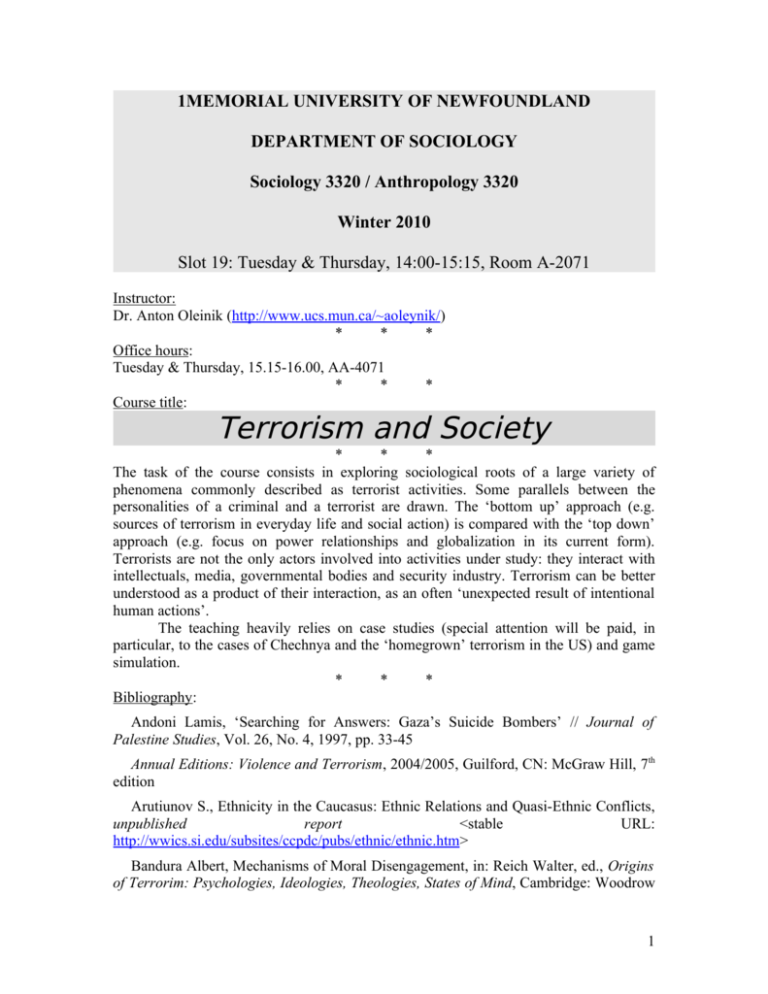
1MEMORIAL UNIVERSITY OF NEWFOUNDLAND
DEPARTMENT OF SOCIOLOGY
Sociology 3320 / Anthropology 3320
Winter 2010
Slot 19: Tuesday & Thursday, 14:00-15:15, Room A-2071
Instructor:
Dr. Anton Oleinik (http://www.ucs.mun.ca/~aoleynik/)
*
*
*
Office hours:
Tuesday & Thursday, 15.15-16.00, AA-4071
*
*
*
Course title:
Terrorism and Society
*
*
*
The task of the course consists in exploring sociological roots of a large variety of
phenomena commonly described as terrorist activities. Some parallels between the
personalities of a criminal and a terrorist are drawn. The ‘bottom up’ approach (e.g.
sources of terrorism in everyday life and social action) is compared with the ‘top down’
approach (e.g. focus on power relationships and globalization in its current form).
Terrorists are not the only actors involved into activities under study: they interact with
intellectuals, media, governmental bodies and security industry. Terrorism can be better
understood as a product of their interaction, as an often ‘unexpected result of intentional
human actions’.
The teaching heavily relies on case studies (special attention will be paid, in
particular, to the cases of Chechnya and the ‘homegrown’ terrorism in the US) and game
simulation.
*
*
*
Bibliography:
Andoni Lamis, ‘Searching for Answers: Gaza’s Suicide Bombers’ // Journal of
Palestine Studies, Vol. 26, No. 4, 1997, pp. 33-45
Annual Editions: Violence and Terrorism, 2004/2005, Guilford, CN: McGraw Hill, 7th
edition
Arutiunov S., Ethnicity in the Caucasus: Ethnic Relations and Quasi-Ethnic Conflicts,
unpublished
report
<stable
URL:
http://wwics.si.edu/subsites/ccpdc/pubs/ethnic/ethnic.htm>
Bandura Albert, Mechanisms of Moral Disengagement, in: Reich Walter, ed., Origins
of Terrorim: Psychologies, Ideologies, Theologies, States of Mind, Cambridge: Woodrow
1
Wilson International Center for Scholars and Cambridge University Press, 1990, pp. 161191
Bell Stewart, ‘The Making of a Canadian Terrorist’, Maclean’s, August 22, 2005, pp.
16-20
Brym Robert and Araj Bader, ‘Suicide Bombing as Strategy of Interaction: The Case
of the Second Intifada’, Social Forces, Vol. 84, No. 4, June 2006, pp. 1969-1986 <stable
URL: http://www.chass.utoronto.ca/soc101y/brym/BrymAraj.pdf>
Brym Robert, Intellectuals and Politics, London: George Allen & Unwin (Publishers)
Ltd, 1980 <stable URL: http://www.chass.utoronto.ca/brym/ipALL.html#radicalism>
Butler Linda, ‘Suicide Bombers: Dignity, Despair and the Need for Hope: An
Interview with Eyad El Sarraj’, Journal of Palestine Studies, Vol. 31, No. 4, 2002, pp.
71-76
Centre for the Study of Globalization and Regionalization, Democratizing the Global
Economy: The Role of Civil Society, Warwick, UK, 2004 <stable URL:
www2.warwick.ac.uk/fac/soc/csgr/research/projects/englishreport.pdf>
Enders Walter and Todd Sandler, The political economy of terrorism, Cambridge:
Cambridge University Press, 2006
Erickson Richard, Crime in an Insecure World, Cambridge: Polity Press, 2007,
Chapter 2
Frey Bruno, Dealing with Terrorism: Stick or Carrot?, Cheltenham: Edward Elgar
Pub., 2004
Friscolanti Michael, Gatehouse Jonathon and Gillis, Charlie, ‘Homegrown Terror: It’s
not over’, Maclean’s, June 19th, 2006, pp. 18-25
Gambetta Diego, ‘Reason and Terror: Has 9/11 made it hard to think straight?’,
Boston
Review,
April/May
2004
<stable
URL:
http://www.bostonreview.net/BR29.2/gambetta.html>
Gambetta Diego, ‘“In the beginning was the Word”… The symbols of the Mafia’,
Archives Européennes de sociologie, Vol. XXXII, 1991, pp. 53-77
Gareau Frederick H., State Terrorism and the US: From Counterinsurgency to the
War on Terrorism, Atlanta: Clarity Press and London: Zed books, 2004
Heyboer Kelly, ‘Face to Face with a Suicide Bomber’, American Journalism Review,
June 2002, Vol. 24, Issue 5, pp. 10-12
Howard Russell, Forest James and Moore Joanne, Homeland Security and Terrorism:
Readings and Interpretations, New York: McGraw-Hill, 2006
Howard Russell and Sawyer Reid, Defeating Terrorism: Shaping the New Security
Environment, Guilford, CT: McGraw Hill, 2004
Martin, Gus, Understanding Terrorism, Thousand Oaks, CA: SAGE Publications, 2006.
2nd edition
2
Media Education Foundation, Hijacking Catastrophe: Study Guide, 2004 <stable
URL:
http://www.mediaed.org/videos/CommercialismPoliticsAndMedia/Hijacking_Catastroph
e/studyguide/hijacking_castastrophe.pdf>
Oleinik Anton, Organized Crime, Prison and Post-Soviet Societies, Aldershot, UK:
Ashgate, 2003. Preface by Alain Touraine
Oleinik Anton, ‘A Distrustful Economy: An Inquiry into Foundations of the Russian
Market’, Journal of Economic Issues, Vol. XXXIX, No. 1, March 2005 <stable URL:
http://www.ucs.mun.ca/~aoleynik/publications/oleinik-JEI-2.pdf>
Pape Robert A., ‘The Strategic Logic of Suicide Terrorism’, American Political
Science Review, Vol. 97, No. 3, August 2003, pp. 343-361
Poland, James M., Understanding Terrorism: Groups, Strategies, and Responses,
Upper Saddle River, NJ: Pearson – Prentice Hall, 2005. 2nd edition
Schelling Thomas, The Strategy of Conflict, Cambridge: Harvard University Press,
1960
Snowden Lynne and Whistel Bradley, Terrorism: Research, Readings and Realities,
Upper Saddle River, NJ: Person – Prentice Hall, 2005
Soros George, The Age of Fallibility: The Consequences of the War on Terror, Public
Affairs, 2006
Soto Hernando de, The Other Path: The Economic Answer to Terrorism, New York:
Basic Books, 2002 (1989) <stable URL: http://www.ild.org.pe/eng/other_en.htm>
Stern Jessica, The Ultimate Terrorists, Cambridge, MA and London: Harvard
University Press, 1999
Tilly Charles, ‘Terror, Terrorism, Terrorists’, Sociological Theory, Vol. 22, No. 1,
March 2004, pp. 5-13
Tilly Charles, ‘Violence, Terror, and Politics as Usual: America’s “new war” reflects
an epochal change in the nature of collective violence’, Boston Review, Summer 2002
<stable URL: http://www.bostonreview.net/BR27.3/tilly.html#4>
Tilly Charles, ‘War Making and State Making as Organized Crime’, in: Evans Peter,
Rueschemeyer Dietrich and Skocpol Theda, eds., Bringing the State Back In, Cambridge:
Cambridge University Press, 1985, pp. 169-191
Turk Austin T, ‘Sociology of Terrorism’, Annual Review of Sociology, 30: 271-286,
2004
Wieviorka Michel, The Making of Terrorism, Translated by David Gordon White,
With a new preface, Chicago and London: The University of Chicago Press, 2004
White Jonathan R., Terrorism: An Introduction, Belomont, CA: Thomson –
Wadsworth, 2003. 4th edition
Zulaika Joseba and Douglass William A., Terror and Taboo: The Follies, Fables, and
Faces of Terrorism, New York and London: Routledge, 1996
3
*
*
*
Method of Evaluation:
Class attendance and participation (participation in class discussions and/
or submitting occasional one-page papers)
1st writing assignment
Mid-term test
2nd writing assignment
Final exam
*
*
*
Course description:
%
10
15
15
20
40
1. Introduction
A suspicious concept. Terrorist or freedom fighter. A plurality of definitions (an
experiment). Methodological remark: conventional nature of concepts. Violence and its
types. Old and new (post 9/11) tendencies in terrorist activities.
MARTIN, Chapter 2; TURK; TILLY, 2004
2. Focus on the terrorist’s personality
Merton’s taxonomy of deviant behavior. Studies in the personality of a criminal.
How one becomes a terrorist: life stories. Case study: Mohamed Atta, one of the 9/11
hijackers <‘The shy, caring, deadly fanatic’, stable URL: http://observer.guardian.co.uk/
waronterrorism/story/0,1373,556630,00.html; ‘A Fanatic’s Quiet Path to Terror’, stable
URL:
http://www.washingtonpost.com/ac2/wp-dyn?
pagename=article&contentId=A6745-2001Sep21&notFound=true>
BANDURA; WHITE, Chapter 2; ANNUAL EDITIONS, pp. 152-161 (article 26);
ANDONI; BUTLER; STEWART; BELL
3. Economic approach to terrorism
Explanations based on the model of rational choice. Theorizing threats with the help of
game theory. Empirical evidence supporting the thesis about the strategic logic of suicide
terrorism. Counterarguments.
FREY; PAPE; BRYM AND BADER, 2005
4. The bottom up approach
Interactionist perspective. Game simulation: terrorism as a play.
Sociology of action’s perspective. Movement and anti-movement.
Predictions about terrorists’ tactics.
ZULAIKA, Chapter 3; SNOWDEN and WHITSEL, Chapter 1; WIEVIORKA,
Chapters 1 and 5
5. The top down approach
Power and its types. Imposed power.
State-sponsored terrorism. Genocide and politicide. Outsourcing (militia).
4
Embededdness in the processes of non-democratic globalization. Invidious comparison.
Institutional importation.
Predictions about terrorists’ tactics.
GAREAU, Introduction, Chapter 10; OLEINIK, 2005, Section ‘Type of Authority
as a Parameter of the Institutional Environment’; ZULAIKA, Chapter 6; TILLY, 1985;
TILLY, 2002; CENTRE FOR THE STUDY OF GLOBALIZATION AND
REGIONALIZATION
6. Principal actors and their interlocking interests
Terrorists: a network approach. A blind cell structure. Network structures in the cases of
Mafia, drug dealers (P. Kopp), organized crime.
Medias (cf. the case of Mafia)
Intellectuals. Violence in the academia. Functionalist and network approaches. Case
study: the Unabomber file <stable URL: http://www.unabombertrial.com/index.html;
http://en.wikipedia.org/wiki/Unabomber>.
State officials
Power institutions
Security industry
WIEVIORKA, Chapters 2 and 3; WHITE, Chapters 3 and 16; BRYM, 1980,
Section ‘Intellectuals and Politics’; HEYBOER; GAMBETTA, 1991; ANNUAL
EDITIONS, pp. 120-124 (article 20); HOWARD, RUSSEL AND MOORE, Chapter 22;
OLEYNIK, 2004
7. Counterterrorism
Technical solutions. The USA PATRIOT Act debate
Military solutions. The torture debate
Economic solutions
Political solutions
Social solutions
HOWARD, RUSSEL AND MOORE, Chapter 24; HOWARD, SAWYER, pp. 5173, 119-126; FRISCOLANTI ET AL.; DE SOTO, Preface; ZULAIKA, Chapter 7;
BUCKLEY AND MEESE
8. Case studies
Chechnya. Case study: web-sites of Chechen separatists (www.chechenpress.com,
www.kavkazcenter.com; a selection of articles published in New York Times). Game
simulation: hostages crisis
The American terrorism
OLEINIK, 2003, pp. 181-187, 267-269 (Postscript); GAREAU, pp. 212-213;
ARUTIUNOV; MARTIN, Chapter 12; WHITE, Chapter 14
5
Time schedule:
# Topic
#
1 1. Introduction
2 1. Introduction
3 2. Focus on the terrorist’s personality
4 2. Focus on the terrorist’s personality
5 3. Economic approach to terrorism
6 3. Economic approach to terrorism
7 4. The bottom up approach
8 4. The bottom up approach
9 4. The bottom up approach
10 4. The bottom up approach
11 5. The top down approach
Deadline for submission of the 1st writing assignment
12 5. The top down approach
13 5. The top down approach
Winter semester break: No lectures
14 5. The top down approach
15 6. Principal actors and their interlocking interests
16 6. Principal actors and their interlocking interests
Mid-term test
17 6. Principal actors and their interlocking interests
18 6. Principal actors and their interlocking interests
19 7. Counterterrorism
20 Movie Hijacking Catastrophe
21 7. Counterterrorism
22 7. Counterterrorism
23 8. Case studies
24 8. Case studies
Deadline for submission of the 2nd writing assignment
25 Final discussion / make up session
Final exam
The outline may be subjected to changes
Date
7/1
12/1
14/1
19/1
21/1
26/1
28/1
2/2
4/2
9/2
11/2
16/2
18/2
23/2
25/2
2/3
4/3
9/3
11/3
16/3
18/3
23/3
25/3
30/3
1/4
6/4
6

